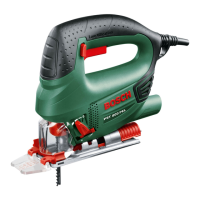Noise/Vibration Information
Noise emission values determined according to
EN 62841‑2‑11.
Typically, the A-weighted noise level of the power tool is: Sound pressure level 88 dB(A); sound power level 99
dB(A). Uncertainty K = 5 dB.
Wear hearing protection!
Vibration total values ah (triax vector sum) and uncertainty K determined according to EN 62841‑2‑11:
Cutting boards with saw blade T 144 D:
a
h,B
= 10 m/s
2
, K = 3 m/s
2
cutting sheet metal with saw blade T 118 A:
a
h,M
= 11 m/s
2
, K = 3 m/s
2
The vibration level and noise emission value given in these instructions have been measured in accordance with a
standardized measuring procedure and may be used to compare power tools. They may also be used for a
preliminary estimation of vibration and noise emissions.
The stated vibration level and noise emission value represent the main applications of the power tool. However, if the
power tool is used for other applications, with different application tools or is poorly maintained, the vibration level and
noise emission value may differ. This may significantly increase the vibration and noise emissions over the total
working period.
To estimate vibration and noise emissions accurately, the times when the tool is switched off or when it is running but
not actually being used should also be taken into account. This may significantly reduce vibration and noise
emissions over the total working period.
Implement additional safety measures to protect the operator from the effects of vibration, such as servicing the
power tool and application tools, keeping their hands warm, and organizing workflows correctly.
Assembly
Pull the plug out of the socket before carrying out any work on the power tool.
Inserting/changing the saw blade
When fitting or changing the saw blade, wear protective gloves.
Blades are sharp and can become hot when used for prolonged periods of time.
Selecting the saw blade
You will find an overview of recommended saw blades at the end of these operating instructions. Only use saw
blades with a single lug shank (T shank) or with a 1/4″ universal shank (U shank). The saw blade should not be
longer than required for the intended cut.
Use a narrow saw blade when sawing tight curves.
Inserting the saw blade (see figures A and E)
Clean the shaft on the saw blade before inserting it.
A dirty shaft cannot be securely fixed in place.
Push the saw blade receptacle (14) upwards in the direction of the arrow. Push the saw blade (9), with the teeth in the
cutting direction, into the saw blade receptacle as far as it will go.
Make sure when inserting the saw blade that the back of the saw blade is in the groove on the guide roller (8).
Precise cuts are only possible if the guide roller (8) fits closely – but not too tightly – against the back of the saw blade
(ensure that the saw blade (9) is not bent by the guide roller). If necessary, loosen the screw (18) and slide the
bracket (17) for the guide roller so that the guide roller fits closely against the back of the saw blade. Retighten the
screw (18).
Check that the saw blade is seated securely.
A loose saw blade can fall out and lead to injuries.
Removing the saw blade (see figure B)
Push the saw blade receptacle (14) upwards in the direction of the arrow and remove the saw blade (9).

